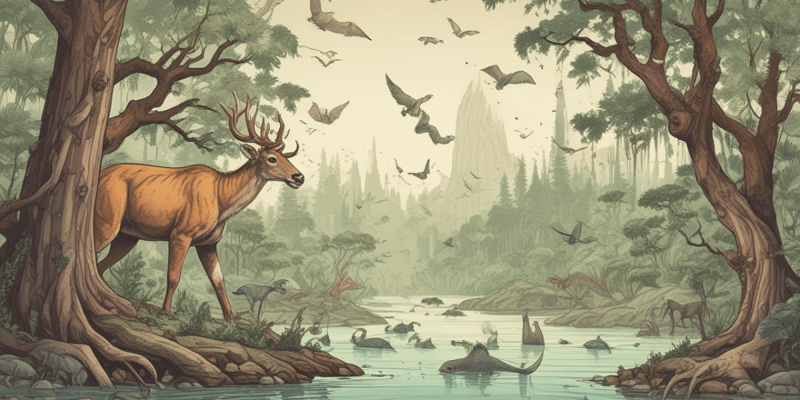Podcast
Questions and Answers
What is one of the primary drivers of the current biodiversity crisis?
What is one of the primary drivers of the current biodiversity crisis?
Which statement is true regarding the Holocene extinction?
Which statement is true regarding the Holocene extinction?
What does the term 'extirpation' refer to?
What does the term 'extirpation' refer to?
What percentage of known species does E.O. Wilson predict could face extinction by the end of the century?
What percentage of known species does E.O. Wilson predict could face extinction by the end of the century?
Signup and view all the answers
Which group of organisms is particularly at risk according to the current biodiversity crisis?
Which group of organisms is particularly at risk according to the current biodiversity crisis?
Signup and view all the answers
What is the leading cause of the modern biodiversity crisis in terrestrial ecosystems?
What is the leading cause of the modern biodiversity crisis in terrestrial ecosystems?
Signup and view all the answers
Which species is cited as having been driven to extinction by overharvesting during the 19th century?
Which species is cited as having been driven to extinction by overharvesting during the 19th century?
Signup and view all the answers
Which of the following large mammals went extinct due to early human activity in North America?
Which of the following large mammals went extinct due to early human activity in North America?
Signup and view all the answers
What role do island endemics play in extinction vulnerability?
What role do island endemics play in extinction vulnerability?
Signup and view all the answers
What is a significant ecological consequence of habitat destruction in aquatic ecosystems?
What is a significant ecological consequence of habitat destruction in aquatic ecosystems?
Signup and view all the answers
Which factor has contributed to the extinction of species in Australia and New Guinea over 40,000 years ago?
Which factor has contributed to the extinction of species in Australia and New Guinea over 40,000 years ago?
Signup and view all the answers
What distinguishes extirpation from extinction?
What distinguishes extirpation from extinction?
Signup and view all the answers
Which of the following events is associated with the extinction of the Dodo bird?
Which of the following events is associated with the extinction of the Dodo bird?
Signup and view all the answers
What is identified as a major factor influencing prehistoric extinctions globally?
What is identified as a major factor influencing prehistoric extinctions globally?
Signup and view all the answers
The Great Auk went extinct primarily due to which of the following?
The Great Auk went extinct primarily due to which of the following?
Signup and view all the answers
What is one characteristic that distinguishes the Holocene extinction from previous mass extinctions?
What is one characteristic that distinguishes the Holocene extinction from previous mass extinctions?
Signup and view all the answers
What generally occurs following a mass extinction event?
What generally occurs following a mass extinction event?
Signup and view all the answers
Which of the following statements is true regarding natural extinctions?
Which of the following statements is true regarding natural extinctions?
Signup and view all the answers
What is the primary cause of the biodiversity crisis mentioned in the content?
What is the primary cause of the biodiversity crisis mentioned in the content?
Signup and view all the answers
Which of the following mass extinction events resulted in the largest percentage of species lost?
Which of the following mass extinction events resulted in the largest percentage of species lost?
Signup and view all the answers
What does extirpation refer to in ecological terms?
What does extirpation refer to in ecological terms?
Signup and view all the answers
Which of the following was a cause of the Ordovician-Silurian extinction?
Which of the following was a cause of the Ordovician-Silurian extinction?
Signup and view all the answers
Which of the following is an example of a consequence of anthropogenic impacts on biodiversity?
Which of the following is an example of a consequence of anthropogenic impacts on biodiversity?
Signup and view all the answers
How many mass extinctions have been commonly recognized in Earth's history?
How many mass extinctions have been commonly recognized in Earth's history?
Signup and view all the answers
What has been a major consequence of human-induced extinction events?
What has been a major consequence of human-induced extinction events?
Signup and view all the answers
Study Notes
Ecology Course Outline
- BIOL-2101 is an Ecology course taught by Prof. Dan Mennill at the University of Windsor.
Course Lectures
- Lecture 1: Introduction to Ecology
- Lecture 2: Environmental Influences
- Lecture 3: Ecological Energetics
- Lecture 4: Nutrient Cycling
- Lecture 5: Population Ecology
- Lecture 6: Behavioral Ecology Part 1
- Lecture 7: Behavioral Ecology Part 2
- Lecture 8: Physiological Ecology
- Lecture 9: Life Histories
- Lecture 10: Community Ecology I
- Lecture 11: Community Ecology II
- Lecture 12: Disturbance & Succession
- Lecture 13: Biomes
- Lecture 14: Biodiversity
- Lecture 15: Biodiversity
- Lecture 16: Landscape Ecology
- Lecture 17: Conservation Part 1
- Lecture 18: Conservation Part 2
- Lecture 19: Resource Ecology
- Lecture 20: Paleoecology
- Lecture 21: Ecology and Society I
- Lecture 22: Ecology and Society II
Lecture 17: Conservation Part I
- Topic: Conservation, Historic & Recent Extinctions
-
Details: Chapter 14 of the textbook
- Meaning of conservation
- Stewardship of the natural world.
- Focus on Biological Conservation.
- Focus of Chapter 14
- Sustainable use of renewable natural resources
- Meaning of conservation
- Key considerations regarding conservation
- Defining the natural world based on genetic, species richness, and landscape levels. This is essential.
- Valuing biodiversity: instrumental, aesthetic, ecosystem services, and intrinsic values.
- The recognition that humans led to a global biodiversity crisis, resulting in biodiversity loss at a catastrophic rate, and now have a responsibility to mitigate the damage.
Natural Extinctions
- Extinctions are a natural part of ecological change.
- Most species that have ever existed are now extinct (99%).
- Mass extinction events occur when large numbers of species go extinct simultaneously.
- Six mass extinctions are documented.
Timeline of Earth's History
- Timeline of Earth's evolutionary history, showing key events like the formation of the Earth, the Moon, and the emergence of life.
- Time scale information including the Hadean, Archean, Proterozoic, Paleozoic, Mesozoic, and Cenozoic eras.
- Occurrences of major extinction events throughout these periods (Ordovician-Silurian, Devonian-Carboniferous, Permian, Triassic-Jurassic, Cretaceous-Tertiary (K/T)).
- Information about the age of major evolutionary events (e.g., first vertebrate land animals, Cambrian explosion, first Hominins, non-avian dinosaurs).
Mass Extinctions
-
1. 440 mya: Ordovician-Silurian extinction: 25% of marine families went extinct, likely due to global cooling.
-
2. 370 mya: Devonian-Carboniferous extinction: 19% of marine families went extinct, potentially caused by volcanic activity and climate change.
-
3. 245 mya: Permian extinction: 54% of families and 96% of species went extinct, likely due to Siberian volcanic activity ("The Great Dying").
-
4. 210 mya: Triassic-Jurassic extinction: 23% of families went extinct, probably due to volcanic activity.
-
5. 65 mya: Cretaceous-Tertiary (K/T) extinction: 17% of families and 76% of species went extinct, possibly due to a meteorite impact in Mexico's Yucatán Peninsula.
-
Data is available for each extinction event.
Extinctions and Adaptive Radiation
- Extinctions can lead to periods of adaptive radiation (appearance of new species).
- The Burgess Shale in British Columbia provides valuable evidence of the Cambrian explosion, a major period of diversification.
- Examples from the Burgess Shale (Wiwaxia, Opabinia, Anomalocaris).
The Holocene Extinction
- The modern biodiversity crisis: A mass extinction.
- Key elements of the biodiversity crisis:
- Species extinction rates are exceptionally high.
- The number of endangered and at-risk species is rapidly increasing worldwide.
- Natural communities are diminishing.
E.O. Wilson's Predictions
- E.O. Wilson predicts half of known species will go extinct within a century.
Causes of Anthropogenic Extinctions
- Over-harvesting: Overuse (e.g., Passenger pigeons)
- Introduction of Alien Species: Competitor species and predators (e.g., Zebra mussels)
- Habitat Destruction: Conversion to agriculture and industry.
- Over-harvesting in aquatic ecosystems The leading cause (e.g., overfishing).
Ecological Labs
- Instructions on optional labs and upcoming due dates for projects (including videos).
Upcoming Due Dates
- Dates for coursework submissions to be posted online.
Science on Tap Event
- An event about birds, details are available as a poster.
Prehistoric Extinctions
- The Pleistocene Overkill hypothesis: early humans, migration, leading to the extinction of many large mammals and predators.
- Examples from North America (extinction of horses, camels, mammoths).
- Examples from other regions (Australia, New Guinea, Madagascar, New Zealand & other locations) - extinctions of large megafauna coincident with human colonization.
Studying That Suits You
Use AI to generate personalized quizzes and flashcards to suit your learning preferences.
Related Documents
Description
Test your knowledge on the current biodiversity crisis and its impacts on species extinction. Answer questions regarding primary drivers, extirpation, and predictions made by experts like E.O. Wilson. This quiz covers key concepts essential for understanding environmental science.




